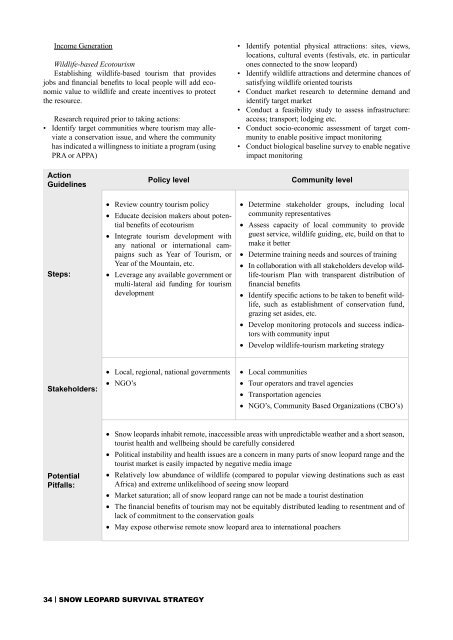Snow Leopard Survival Strategy - Panthera
Snow Leopard Survival Strategy - Panthera
Snow Leopard Survival Strategy - Panthera
Create successful ePaper yourself
Turn your PDF publications into a flip-book with our unique Google optimized e-Paper software.
Income Generation<br />
Wildlife-based Ecotourism<br />
Establishing wildlife-based tourism that provides<br />
jobs and financial benefits to local people will add economic<br />
value to wildlife and create incentives to protect<br />
the resource.<br />
Research required prior to taking actions:<br />
• Identify target communities where tourism may alleviate<br />
a conservation issue, and where the community<br />
has indicated a willingness to initiate a program (using<br />
PRA or APPA)<br />
• Identify potential physical attractions: sites, views,<br />
locations, cultural events (festivals, etc. in particular<br />
ones connected to the snow leopard)<br />
• Identify wildlife attractions and determine chances of<br />
satisfying wildlife oriented tourists<br />
• Conduct market research to determine demand and<br />
identify target market<br />
• Conduct a feasibility study to assess infrastructure:<br />
access; transport; lodging etc.<br />
• Conduct socio-economic assessment of target community<br />
to enable positive impact monitoring<br />
• Conduct biological baseline survey to enable negative<br />
impact monitoring<br />
Action<br />
Guidelines<br />
Policy level<br />
Community level<br />
Steps:<br />
• Review country tourism policy<br />
• Educate decision makers about potential<br />
benefits of ecotourism<br />
• Integrate tourism development with<br />
any national or international campaigns<br />
such as Year of Tourism, or<br />
Year of the Mountain, etc.<br />
• Leverage any available government or<br />
multi-lateral aid funding for tourism<br />
development<br />
• Determine stakeholder groups, including local<br />
community representatives<br />
• Assess capacity of local community to provide<br />
guest service, wildlife guiding, etc, build on that to<br />
make it better<br />
• Determine training needs and sources of training<br />
• In collaboration with all stakeholders develop wildlife-tourism<br />
Plan with transparent distribution of<br />
financial benefits<br />
• Identify specific actions to be taken to benefit wildlife,<br />
such as establishment of conservation fund,<br />
grazing set asides, etc.<br />
• Develop monitoring protocols and success indicators<br />
with community input<br />
• Develop wildlife-tourism marketing strategy<br />
Stakeholders:<br />
• Local, regional, national governments<br />
• NGO’s<br />
• Local communities<br />
• Tour operators and travel agencies<br />
• Transportation agencies<br />
• NGO’s, Community Based Organizations (CBO’s)<br />
Potential<br />
Pitfalls:<br />
• <strong>Snow</strong> leopards inhabit remote, inaccessible areas with unpredictable weather and a short season,<br />
tourist health and wellbeing should be carefully considered<br />
• Political instability and health issues are a concern in many parts of snow leopard range and the<br />
tourist market is easily impacted by negative media image<br />
• Relatively low abundance of wildlife (compared to popular viewing destinations such as east<br />
Africa) and extreme unlikelihood of seeing snow leopard<br />
• Market saturation; all of snow leopard range can not be made a tourist destination<br />
• The financial benefits of tourism may not be equitably distributed leading to resentment and of<br />
lack of commitment to the conservation goals<br />
• May expose otherwise remote snow leopard area to international poachers<br />
34 | SNOW LEOPARD SURVIVAL STRATEGY
















